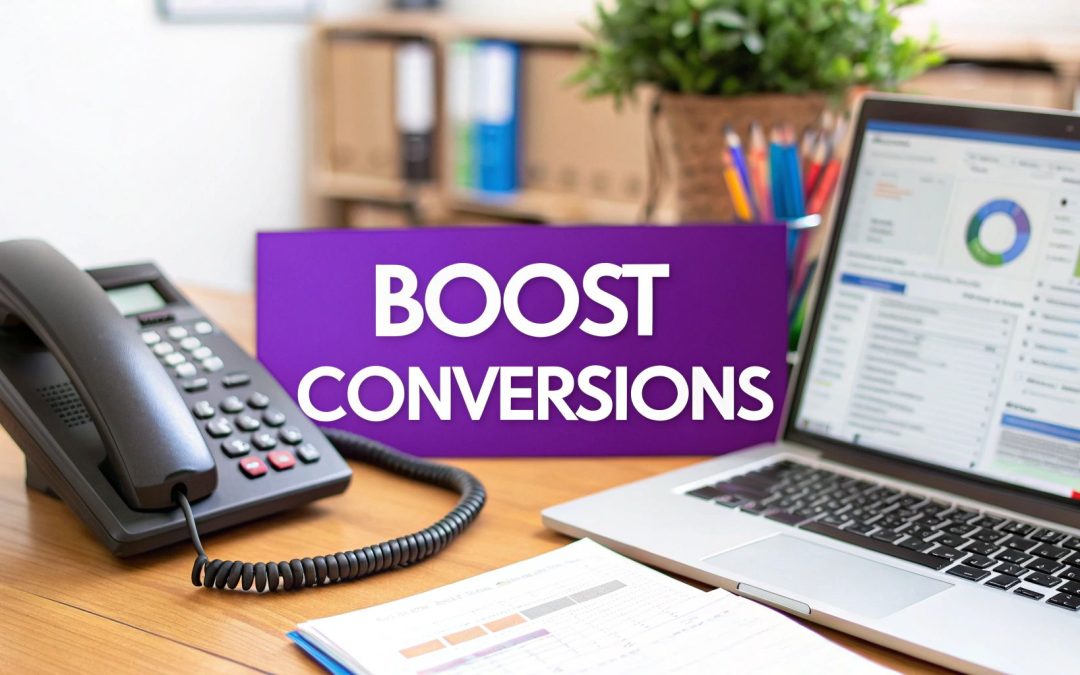In the competitive home services industry, a lead is just the beginning. The real challenge, and where profit is made, lies in converting that initial interest into a booked appointment and a loyal customer. Many businesses focus heavily on generating more calls and form fills but overlook the critical steps that turn a prospect into a paying client. This oversight means missed opportunities and wasted marketing spend. Optimizing your process is not just about small tweaks; it is fundamental to sustainable growth.
This article provides 10 powerful, practical ways to increase conversion rates, specifically tailored for home service companies. We'll move beyond generic advice and dive into actionable strategies. You will learn about everything from landing page optimization and building trust with social proof to analyzing your entire CRO funnel and leveraging exit-intent popups. Each tactic is designed to help you maximize the value of every single lead you generate.
These strategies are distinct from simply boosting sales numbers. For a comprehensive guide on unlocking your business's full potential and turning tactics into tangible results, learn more about how to increase sales conversion that actually grows revenue. If you're ready to stop leaving money on the table, these proven tactics are your blueprint for growth.
1. Optimize Your First Impression: A/B Testing & Optimization
Your website's first impression is often the deciding factor for a potential customer. A/B testing, also known as split testing, is a methodical, data-driven approach to discovering what resonates most with your audience. This process involves creating two or more versions of a single element, like a webpage headline or a call-to-action button, and showing them to different segments of your audience simultaneously. By measuring which version leads to more conversions, you eliminate guesswork and make decisions based on actual user behavior. This is one of the most effective ways to increase conversion rates because it refines the initial touchpoint where most leads are won or lost.
How to Implement A/B Testing
For a home service business, this could mean testing a "Get a Free Quote" button against a "Schedule Your Estimate" button. While they seem similar, one might imply a faster, no-obligation process that appeals more to your target customer. A local HVAC company, for instance, could test two headlines: the trustworthy "Your Local AC Repair Experts" versus the urgent "Fast, 24/7 Emergency AC Service." The latter might convert better during a heatwave.
Actionable Tips for Success
- Test One Variable: To get clear results, only change one element at a time. If you change the headline, button color, and main image all at once, you won't know which change drove the result.
- Focus on High-Impact Pages: Start by testing elements on your most-visited pages, such as your homepage or main service pages, to see results faster.
- Ensure Statistical Significance: Use a tool or calculator to confirm your results aren't due to random chance. Platforms like Google Optimize, Optimizely, and VWO handle this for you.
- Run for a Full Business Cycle: Let tests run long enough to capture different user behaviors, including weekdays and weekends, to get a complete picture.
2. Landing Page Optimization
A landing page is a specialized, standalone page built with a single goal: converting a visitor into a lead. Unlike a homepage with multiple navigation options, a landing page removes distractions and focuses user attention on one specific call-to-action. Optimizing these pages involves refining every element, from the headline to the form fields, to maximize the number of visitors who take that desired action. This focused approach is one of the most direct ways to increase conversion rates because it aligns precisely with a specific marketing campaign's objective.
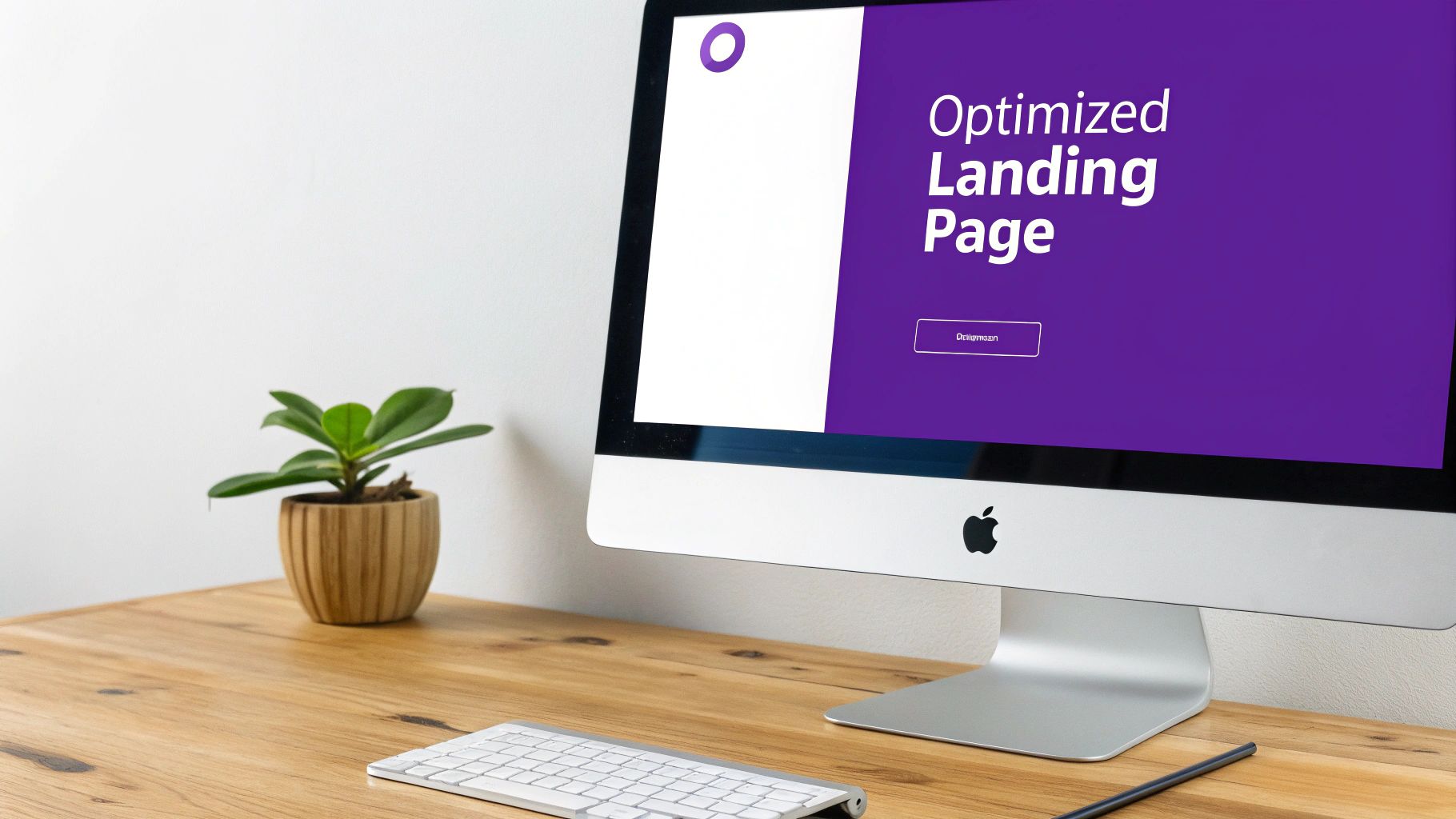
How to Implement Landing Page Optimization
For a plumbing business running a Google Ad campaign for "emergency leak repair," the landing page should speak directly to that urgent need. The headline could be "Fast 24/7 Emergency Leak Repair in [Your City]" instead of a generic "Welcome to Our Plumbing Services." The page should feature a simple contact form, a prominent phone number, and social proof like testimonials from customers who received emergency service. This ensures the message from the ad is perfectly matched on the page, reassuring the visitor they've come to the right place. For a comprehensive approach, refer to our guide on the Top 10 Landing Page Design Best Practices to ensure your storefront is irresistible.
Actionable Tips for Success
- Match Message to Ad: Ensure the headline and content on your landing page directly reflect the promise made in the ad that brought the visitor there.
- Minimize Friction: Only ask for essential information in your forms. A name, phone number, and a brief description of the issue are often enough to start a conversation.
- Build Trust Instantly: Include trust signals like customer testimonials, industry certifications (e.g., BBB A+), or "satisfaction guaranteed" badges.
- Focus on a Single Goal: Remove all unnecessary navigation links or competing offers. The only clickable action should be your primary call-to-action, such as "Request Service Now."
3. Social Proof & Trust Signals
Potential customers often rely on the actions and opinions of others to guide their own decisions, a psychological principle known as social proof. By strategically displaying customer reviews, testimonials, industry certifications, and security badges, you build credibility and reduce the perceived risk for a new buyer. Integrating these trust signals is one of the most powerful ways to increase conversion rates because it shows prospects that others have already hired and trusted your business, making them feel more confident in their choice.
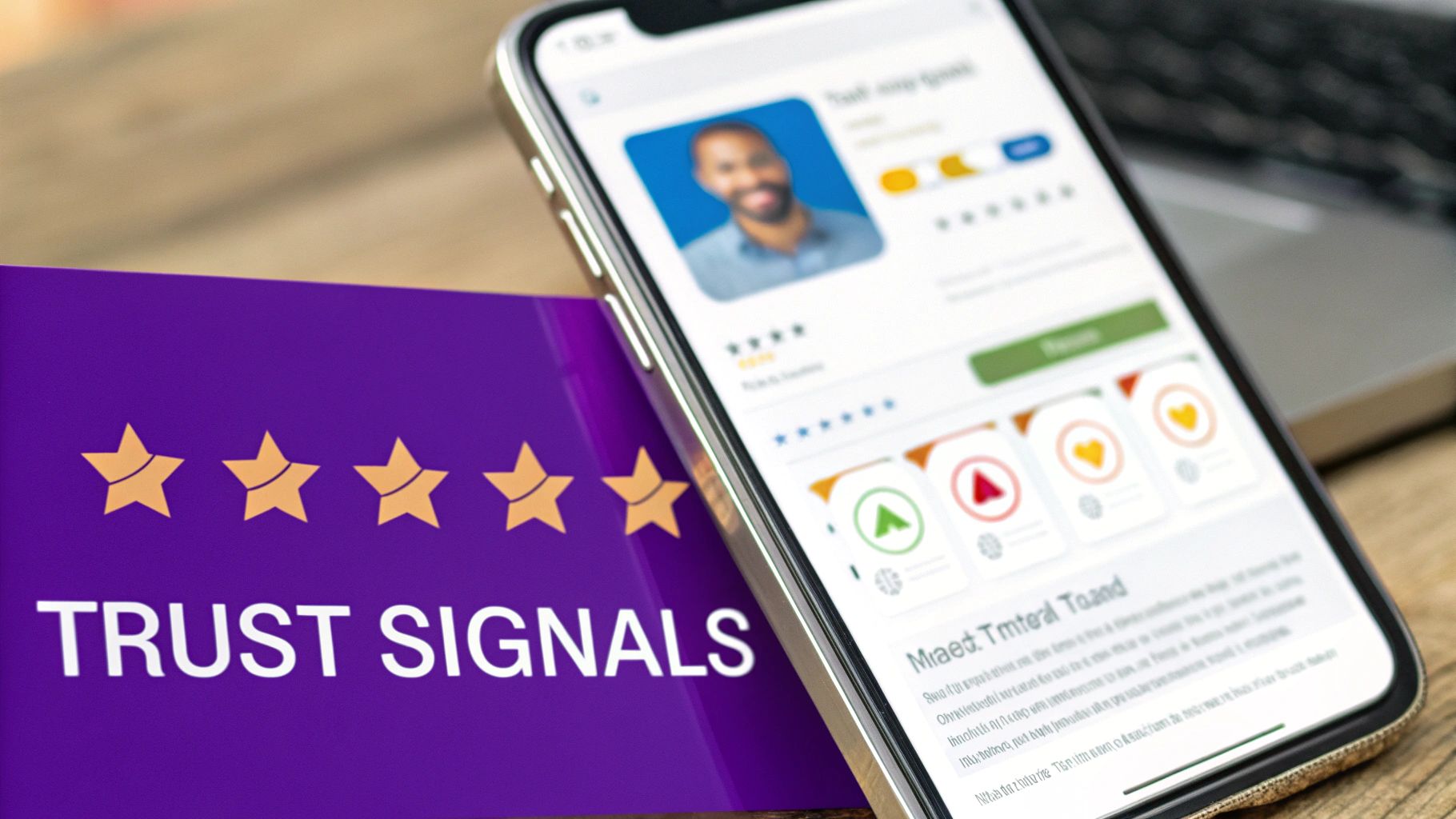
How to Implement Social Proof
For a home service business, this means showcasing your 5-star Google or Yelp reviews directly on your service pages. An electrician could feature a short video testimonial from a happy homeowner who had their entire house rewired, addressing common concerns like timeliness and cleanliness. A plumbing company might display logos of local businesses they service or certifications like "Master Plumber" to establish authority and expertise, reassuring visitors that they are qualified for the job.
Actionable Tips for Success
- Be Specific: Instead of saying "satisfied customers," use specific numbers like "Trusted by over 500 local homeowners."
- Use Visuals: Whenever possible, add a headshot and the customer's full name to testimonials. This simple step makes the review feel more authentic and relatable.
- Display Trust Badges: Prominently feature security seals (like SSL certificates), industry association logos (like the NARI or ACCA), and "satisfaction guaranteed" badges near your contact forms or quote request buttons.
- Keep It Fresh: Regularly update your featured testimonials to ensure they are recent and relevant, demonstrating ongoing customer satisfaction.
4. Call-to-Action (CTA) Optimization
Your call-to-action is the pivotal moment where you ask a visitor to become a lead. Strategic CTA optimization involves the precise design, wording, and placement of the buttons and links that guide users toward your conversion goal. By using persuasive language, contrasting colors, and clear placement, you can transform a passive website visitor into an active, engaged lead. Refining your CTAs is one of the most direct ways to increase conversion rates because it removes friction at the final step of the user's decision-making process.
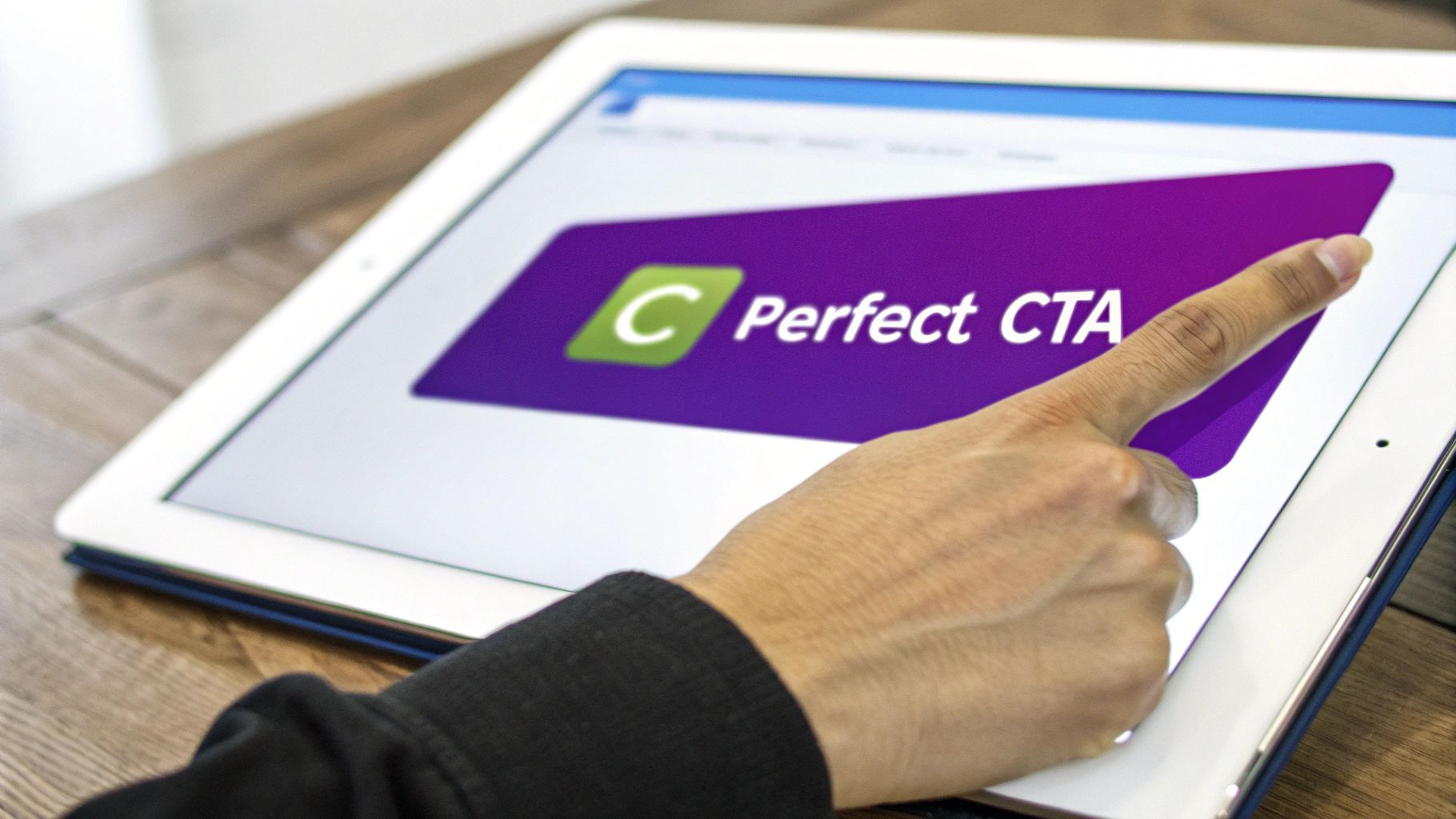
How to Implement CTA Optimization
For a home service business, optimizing CTAs means moving beyond generic phrases like "Submit." Instead, a plumber could test a button that says "Get My Free Plumbing Quote" against "Schedule Service Now." The first option emphasizes value and removes the feeling of commitment, while the second implies immediate action. Similarly, an electrician might find that a bright orange "Request Emergency Service" button converts far better on their homepage than a standard blue "Contact Us" link, especially for users seeking urgent help.
Actionable Tips for Success
- Use First-Person Language: Phrasing CTAs from the user's perspective, like "Get My Free Estimate" instead of "Get Your Free Estimate," can create a sense of ownership and increase clicks.
- Create Urgency: Incorporate time-sensitive words like "Now," "Today," or "Limited Time Offer" to encourage immediate action from potential customers.
- Emphasize Visual Contrast: Your CTA button should stand out. Use a color that contrasts with your website's primary color scheme to draw the user's eye directly to it.
- Place It Above the Fold: Ensure your primary CTA is visible without the user having to scroll down the page. This placement captures attention immediately.
5. Personalization & Dynamic Content
Generic, one-size-fits-all marketing no longer connects with today's savvy customers. Personalization is the practice of delivering customized content, offers, and experiences based on user data like behavior, location, or past interactions. By tailoring your website and communications to an individual's specific needs and interests, you create a more relevant and engaging experience. This strategy is one of the most powerful ways to increase conversion rates because it makes potential customers feel understood and valued, significantly boosting their likelihood to convert.
How to Implement Personalization
For a home service business, this could mean using dynamic content on your website. For example, a visitor from a coastal, high-humidity area could be shown a prominent banner for dehumidifier installation services, while a visitor from a colder climate sees promotions for furnace maintenance. Another powerful tactic is personalizing follow-up emails. A customer who previously requested a quote for a plumbing repair could receive an automated email a few months later with a subject line like, "Still thinking about that plumbing fix, [Customer Name]?"
Actionable Tips for Success
- Start with Segmentation: Begin by grouping your audience into broad categories, such as new vs. returning visitors or by geographic location, before diving into one-to-one personalization.
- Use Dynamic CTAs: Change your call-to-action buttons based on a user's stage in the customer journey. A first-time visitor might see "Learn More," while a returning lead sees "Get Your Free Estimate."
- Personalize Email Content: Go beyond just using a customer's first name. Reference their specific service interest or the last time they contacted you to make the communication highly relevant.
- Respect User Privacy: Always be transparent about the data you collect and provide clear opt-out options. Trust is a critical component of effective personalization and is central to excellent customer communication strategies.
6. Conversion Rate Optimization (CRO) Funnel Analysis
A conversion funnel maps the entire customer journey, from their first interaction with your brand to the final action, like booking a service. Funnel analysis is a systematic approach to examining each stage of this journey to pinpoint where potential customers are dropping off. By identifying these "leaks," you can implement targeted fixes to reduce friction and guide more users toward conversion. This is one of the most powerful ways to increase conversion rates because it shifts the focus from just the final click to optimizing the entire path a customer takes.
How to Implement Funnel Analysis
For a home service business, the funnel might start with a user landing on your website (Awareness), then navigating to a specific service page like "Plumbing Repair" (Consideration), and finally filling out a contact form to book an appointment (Decision). Funnel analysis tools like Google Analytics or Hotjar can reveal exactly where users abandon this path. If you see a major drop-off on your "Schedule Service" page, it signals a problem with the form itself, perhaps it's too long or asks for unnecessary information.
The infographic below illustrates a simplified three-stage funnel and highlights common drop-off points.
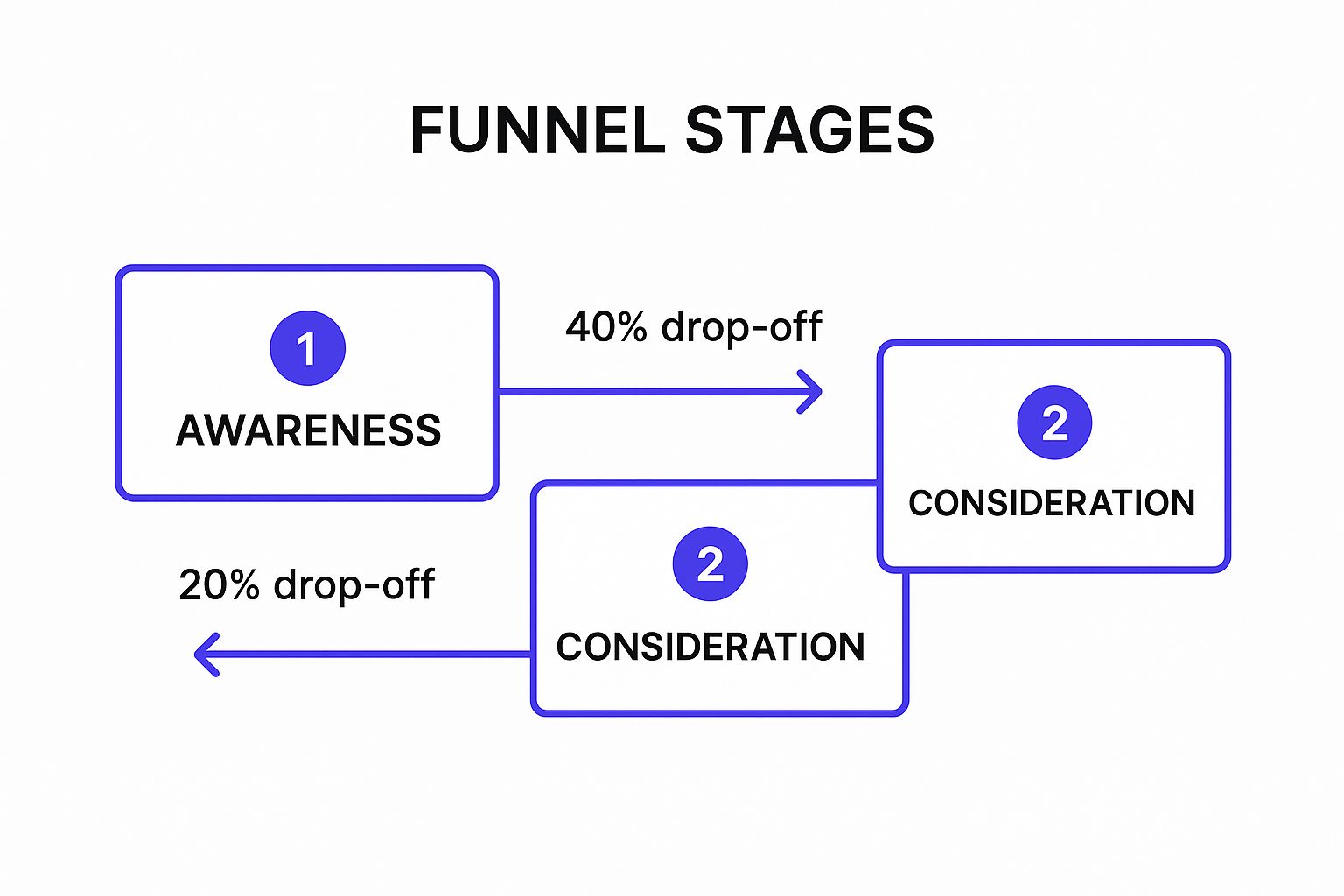
This visualization shows that the largest leak often occurs early, emphasizing the need to make a strong initial impression and provide clear value.
Actionable Tips for Success
- Focus on the Biggest Leaks: Identify the stage with the highest drop-off rate and concentrate your optimization efforts there first for the greatest impact.
- Simplify Complex Steps: If your booking process involves multiple pages and fields, consolidate it. A one-page form is often more effective than a multi-step process.
- Use Heatmaps: Tools like Hotjar create visual heatmaps that show where users click, move, and scroll, revealing how they interact with your pages and where they get stuck.
- Implement Exit-Intent Surveys: When a user is about to leave a key page without converting, a small pop-up can ask why. This provides direct feedback on what's causing friction.
7. Mobile Optimization & Responsive Design
With the majority of local searches happening on smartphones, your website's mobile experience is no longer optional; it's the primary way customers find you. Mobile optimization ensures your site is easy to view and use on any device, from a small phone to a large tablet. This involves responsive design, where your site's layout automatically adjusts to fit the user's screen size. By creating a seamless mobile experience with fast loading times and touch-friendly navigation, you make it effortless for on-the-go customers to contact you, making this one of the most critical ways to increase conversion rates.
How to Implement Mobile Optimization
For a home service business, this means a customer searching for an "emergency plumber near me" on their phone can immediately find and tap your number to call. A responsive design would ensure your "Request an Estimate" form is simple, with large fields and buttons that are easy to press, rather than a tiny, hard-to-navigate desktop version. As Google prioritized mobile-first indexing, a poor mobile site not only frustrates users but also hurts your search rankings, making you invisible to potential customers.
Actionable Tips for Success
- Prioritize a Mobile-First Design: Build your website experience for the smallest screen first, then adapt it for larger screens. This forces you to focus on the most essential information and calls-to-action.
- Test on Real Devices: Don't just rely on browser emulators. Test your website on various iPhones, Androids, and tablets to see exactly how it performs in the real world.
- Simplify Forms: Reduce the number of fields in your contact and quote forms. For mobile users, fewer fields mean a much higher completion rate.
- Optimize for Speed: Compress images and minimize code to ensure your pages load in under three seconds. Mobile users are impatient and will abandon slow-loading sites.
8. Exit-Intent Popups & Lead Magnets
Not every website visitor will convert on their first visit, but that doesn't mean the opportunity is lost. Exit-intent popups are a powerful tool designed to re-engage visitors just as they are about to leave your site. By tracking mouse movements, this technology triggers a last-chance offer when a user moves their cursor towards the close or back button. This strategic interruption provides one final opportunity to capture a lead, making it one of the most effective ways to increase conversion rates by recovering otherwise lost traffic.
How to Implement Exit-Intent Popups
For a home service business, an effective exit-intent popup could offer a "10% Off Your First Service" coupon in exchange for an email address. A roofing company might present a valuable lead magnet, like a free downloadable guide on "5 Signs You Need a Roof Replacement," to capture the contact information of homeowners in the research phase. This turns a departing visitor into a warm lead for your email nurture sequence, giving you another chance to earn their business.
Actionable Tips for Success
- Offer Genuine Value: Don't just ask for an email. Provide a compelling discount, a helpful checklist, or an exclusive guide that solves a real problem for your target customer.
- Keep It Simple: Use a clean design with a strong headline, a clear value proposition, and a single call-to-action to avoid overwhelming the user.
- Limit Frequency: Annoying your visitors is counterproductive. Configure your popups to not show again to users who have already converted or closed them out.
- Make Closing Easy: Always include an obvious and easy-to-click "X" or "No, thanks" option to respect the user's choice and avoid a negative brand experience.
9. Page Speed & Performance Optimization
In today's fast-paced digital world, patience is in short supply. Page speed, or how quickly your website's content loads, is a critical factor influencing user experience and search engine rankings. A slow-loading site frustrates potential customers, leading them to abandon your page for a competitor's before your offer even appears. Optimizing your site's performance is one of the most fundamental ways to increase conversion rates because it removes a major barrier between a user's initial interest and their decision to take action.
How to Implement Performance Optimization
For a home service business, a slow site can be the difference between a booked job and a lost lead. A plumbing company, for instance, must ensure its "Emergency Service" page loads instantly on a mobile device, as a customer with a burst pipe won't wait. Similarly, an electrician's photo gallery of past projects must load quickly, or the visual proof of their quality work will never be seen. Studies from major companies like Walmart and Pinterest have shown that even a one-second improvement in load time can boost conversions significantly.
Actionable Tips for Success
- Compress and Optimize Images: Use tools like TinyPNG or ImageOptim to reduce image file sizes without sacrificing quality. This is often the quickest win for page speed.
- Minimize Code: Use tools to minify your HTML, CSS, and JavaScript files, which removes unnecessary characters from the code and reduces file sizes.
- Leverage Browser Caching: Configure your site to store static files like logos and stylesheets in a visitor's browser, allowing pages to load much faster on subsequent visits.
- Use a Content Delivery Network (CDN): A CDN stores copies of your site on servers around the world, delivering content from the server closest to the user for faster load times.
- Monitor Performance: Regularly use tools like Google's PageSpeed Insights or GTmetrix to test your site's speed and identify new areas for improvement.
10. Urgency & Scarcity Psychology
Leveraging psychological triggers like urgency and scarcity can significantly shorten the customer's decision-making process and compel immediate action. This strategy works by creating a sense of time pressure or limited availability, tapping into the natural human fear of missing out (FOMO). By signaling that a valuable offer won't be around forever, you overcome customer procrastination and provide a powerful reason to book now rather than later. This is one of the most effective ways to increase conversion rates because it directly addresses hesitation.
How to Implement Urgency & Scarcity
For a home service business, this could mean offering a "This Week Only: 10% Off All AC Tune-Ups" deal to fill a slow schedule. A plumbing company might promote a limited-time offer for the first 25 customers who book a water heater installation, creating scarcity. Similarly, a cleaning service could display a live counter on their booking page showing "Only 3 morning slots left this week," encouraging visitors to secure a spot before they are gone.
Actionable Tips for Success
- Be Authentic: Ensure your scarcity is genuine. Claiming "only 2 slots left" when you have a wide-open schedule will damage trust if customers find out.
- Combine with Value: Urgency works best when paired with a clear, compelling value proposition. The special offer must be genuinely attractive to the customer.
- Use Specific Numbers: "Only 5 spots available" is more impactful than "Limited spots available." Specificity makes the scarcity feel more real and immediate.
- Test Different Time Frames: Experiment with various offer durations. A 24-hour flash sale might work for some services, while a week-long promotion may be better for others.
10 Strategies for Boosting Conversion Rates Compared
| Strategy | 🔄 Implementation Complexity | 🛠️ Resource Requirements | 📊 Expected Outcomes | 🎯 Ideal Use Cases | ⭐ Key Advantages |
|---|---|---|---|---|---|
| A/B Testing & Optimization | Moderate to high; requires setup and statistical know-how | Significant traffic, testing tools, analytics | Measurable conversion improvements; data-driven | Websites/emails with high traffic; hypothesis testing | Data-driven decisions; continuous improvement; risk mitigation |
| Landing Page Optimization | Moderate; design and content creation needed | Design resources, copywriters, testing platforms | Conversion rates can improve 200-400% | Campaign-specific landing pages | Focused CTA; better tracking; improved UX |
| Social Proof & Trust Signals | Low to moderate; collecting and displaying testimonials | Customer feedback, review platforms, credibility assets | Builds trust, increases perceived value | All industries enhancing credibility | Cost-effective; universal trust builder |
| Call-to-Action (CTA) Optimization | Low; focused on design and wording | Design, copywriting | Direct, often immediate conversion uplifts | Any digital platform needing user action | Cost-effective; easy to test; direct impact |
| Personalization & Dynamic Content | High; complex data and AI integration | CRM, analytics, personalization engines | Higher engagement; increased conversion | Data-rich environments aiming for tailored UX | Increased relevance; boosts loyalty and engagement |
| CRO Funnel Analysis | High; requires comprehensive analytics and expertise | Analytics tools, data analysts | Identifies drop-offs; maximizes traffic value | Multi-stage sales funnels needing optimization | Precise problem identification; ROI improvement |
| Mobile Optimization & Responsive Design | Moderate to high; design and development focus | Development resources, testing on devices | Captures growing mobile traffic; reduces bounce | Mobile-heavy traffic sites; SEO-focused | Future-proofing; improved accessibility |
| Exit-Intent Popups & Lead Magnets | Low to moderate; deployment with behavioral triggers | Popup software, lead magnets, email marketing | Recovers abandoning visitors; email list growth | E-commerce, content sites needing leads | High ROI; easy to implement and test |
| Page Speed & Performance Optimization | Moderate to high; technical expertise required | Technical specialists, performance tools | Faster load times; reduces bounce; improves SEO | All websites where speed impacts conversions | UX boost; SEO benefits; cost savings |
| Urgency & Scarcity Psychology | Low to moderate; mostly content and UI changes | Design, copywriting | Can increase conversions 20-200% | Sales-driven sites, promotions, limited offers | Creates motivation; drives impulse buys |
Turning Tactics into Revenue: Your Next Steps
We've explored ten powerful strategies, from the technical precision of A/B testing and landing page optimization to the psychological nuances of social proof and urgency. Each tactic represents a distinct lever you can pull to enhance your business's performance. However, the true path to mastering these ways to increase conversion rates isn't about implementing every single idea at once. It’s about building a sustainable, data-driven culture of continuous improvement.
The most successful home service businesses don’t view conversion optimization as a one-time project; they see it as an ongoing business function. They understand that a 1% improvement in mobile page speed, a slightly more compelling CTA, or a faster response to an incoming lead can compound over time, leading to significant revenue growth. Your goal should be to move from random acts of marketing to a systematic process of testing, learning, and refining.
Key Takeaways for Sustainable Growth
Remember that at the heart of every conversion is a customer seeking a solution to their problem. Your website, your ads, and your customer service representatives are all part of that solution.
- Build Trust at Every Stage: Elements like social proof, a professional website, and a fast-loading mobile experience are not just technical details. They are foundational signals that tell potential customers you are a credible and reliable choice.
- Data is Your Guide: Don't rely on guesswork. Use CRO funnel analysis to identify where you're losing customers, A/B test your assumptions, and let the numbers guide your decisions on everything from button colors to headline copy.
- Remove All Friction: Every unnecessary form field, every second of page load time, and every confusing navigation step is a potential roadblock. Your mission is to create the smoothest possible path from initial interest to a booked appointment.
Your Actionable Plan Starts Now
Feeling overwhelmed? Don't be. The journey to higher conversions begins with a single step. Select just one or two strategies from this list that you believe will have the most immediate impact on your business.
Perhaps your mobile experience is lagging; start with mobile optimization. If you suspect your CTAs are weak, design an A/B test for a new version. The key is to start small, measure the results, and build momentum. By committing to this iterative process, you transform your website and marketing efforts from a static brochure into a dynamic engine for acquiring new customers and scaling your revenue.
Many of these strategies depend on having the bandwidth to follow up quickly and professionally with every lead. If missed calls and slow responses are costing you conversions, let Phone Staffer provide the dedicated, US-based CSRs and VAs to ensure every opportunity is captured. Visit Phone Staffer to see how our team can help you turn more leads into loyal customers.

